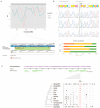Whole Genome Sequencing Reveals the Effects of Recent Artificial Selection on Litter Size of Bamei Mutton Sheep
- PMID: 33445473
- PMCID: PMC7827510
- DOI: 10.3390/ani11010157
Whole Genome Sequencing Reveals the Effects of Recent Artificial Selection on Litter Size of Bamei Mutton Sheep
Abstract
Bamei mutton sheep is a Chinese domestic sheep breed developed by crossing German Mutton Merino sheep and indigenous Mongolian sheep for meat production. Here, we focused on detecting candidate genes associated with the increasing of the litter size in this breeds under recent artificial selection to improve the efficiency of mutton production. We selected five high- and five low-fecundity Bamei mutton sheep for whole-genome resequencing to identify candidate genes for sheep prolificacy. We used the FST and XP-EHH statistical approach to detect the selective sweeps between these two groups. Combining the two selective sweep methods, the reproduction-related genes JUN, ITPR3, PLCB2, HERC5, and KDM4B were detected. JUN, ITPR3, and PLCB2 play vital roles in GnRH (gonadotropin-releasing hormone), oxytocin, and estrogen signaling pathway. Moreover, KDM4B, which had the highest FST value, exhibits demethylase activity. It can affect reproduction by binding the promoters of estrogen-regulated genes, such as FOXA1 (forkhead box A1) and ESR1 (estrogen receptor 1). Notably, one nonsynonymous mutation (p.S936A) specific to the high-prolificacy group was identified at the TUDOR domain of KDM4B. These observations provide a new opportunity to research the genetic variation influencing fecundity traits within a population evolving under artificial selection. The identified genomic regions that are responsible for litter size can in turn be used for further selection.
Keywords: Bamei mutton sheep; breeding; litter size; selection signal analysis; whole-genome sequencing.
Conflict of interest statement
The authors declare no conflict of interest.
Figures



References
-
- Kijas J.W., Lenstra J.A., Hayes B., Boitard S., Porto Neto L.R., San Cristobal M., Servin B., McCulloch R., Whan V., Gietzen K., et al. Genome-Wide Analysis of the World’s Sheep Breeds Reveals High Levels of Historic Mixture and Strong Recent Selection. PLoS Biol. 2012;10:e1001258. doi: 10.1371/journal.pbio.1001258. - DOI - PMC - PubMed
-
- Zhao Y.-X., Yang J., Lv F.-H., Hu X.-J., Xie X.-L., Zhang M., Li W.-R., Liu M.-J., Wang Y.-T., Li J.-Q., et al. Genomic Reconstruction of the History of Native Sheep Reveals the Peopling Patterns of Nomads and the Expansion of Early Pastoralism in East Asia. Mol. Biol. Evol. 2017;34:2380–2395. doi: 10.1093/molbev/msx181. - DOI - PMC - PubMed
-
- Yang J., Li W.-R., Lv F.-H., He S.-G., Tian S.-L., Peng W.-F., Sun Y.-W., Zhao Y.-X., Tu X.-L., Zhang M., et al. Whole-Genome Sequencing of Native Sheep Provides Insights into Rapid Adaptations to Extreme Environments. Mol. Biol. Evol. 2016;33:2576–2592. doi: 10.1093/molbev/msw129. - DOI - PMC - PubMed
-
- Jin X., Su R., Zhang W., Li J. The identification and assessment on genetic characteristics in grading breeding sheep populations with microsatellite markers. Agric. Sci. Technol. 2008;9:21–24.
Grants and funding
LinkOut - more resources
Full Text Sources
Other Literature Sources
Miscellaneous

